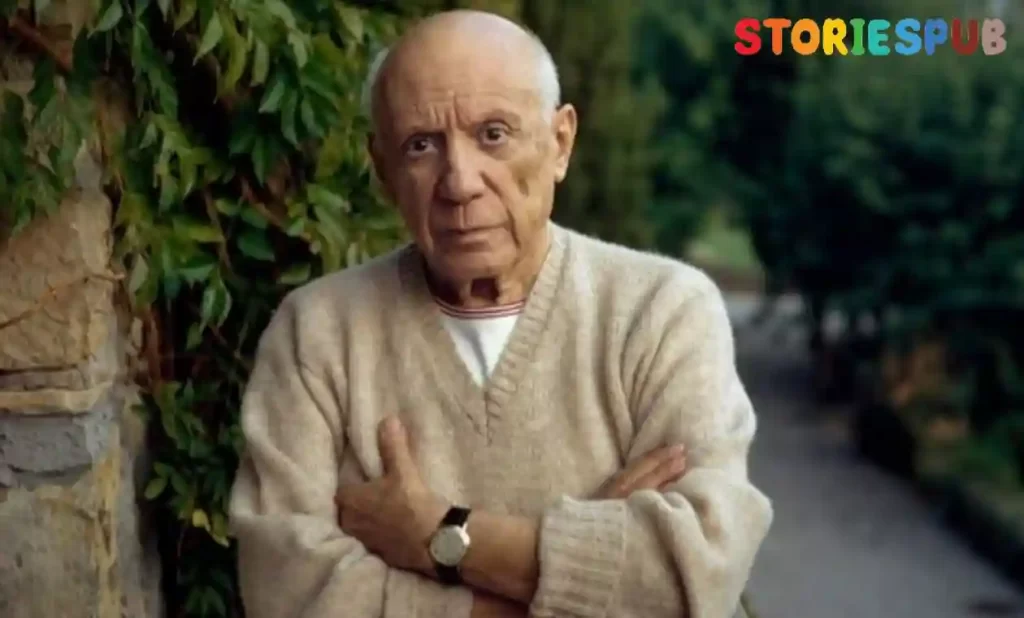Captivating the World with Art: The Pablo Picasso Biography

Image credit : Pinterest
Pablo Picasso, one of the most influential artists of the 20th century, left an indelible mark on the art world. Born on October 25, 1881, in Málaga, Spain, Picasso showed prodigious talent from an early age. His artistic journey began under the guidance of his father, an art professor, and by the age of 15, he was already surpassing the traditional techniques taught to him.
Picasso’s artistic career spanned over seven decades, during which he co-founded the Cubist movement and explored various artistic styles, including Blue Period, Rose Period, and Surrealism.
He revolutionized the art world by challenging conventions and redefining the boundaries of artistic expression. Picasso’s innovative approach, characterized by bold colors, distorted forms, and fragmented perspectives, continues to captivate and inspire artists and art enthusiasts around the globe.
In this article, we delve into the life and artistic journey of this remarkable genius, exploring the influences, milestones, and legacy of Pablo Picasso.
Early Life and Formative Years
Pablo Picasso was born on October 25, 1881, in Málaga, Spain, into a creative and artistic family. His father, José Ruiz y Blasco, was an art teacher, which provided Picasso with early exposure to the world of art. As a child, Picasso showed exceptional artistic talent, surpassing the skills taught to him by his father at a young age.
In his formative years, Picasso received formal art training at various institutions, including the Royal Academy of San Fernando in Madrid. However, he quickly broke away from traditional academic techniques and embarked on a journey of artistic exploration. Influenced by the works of El Greco, Francisco Goya, and the Post-Impressionists, Picasso began experimenting with different styles and techniques, laying the foundation for his distinctive artistic expression.
During this period, Picasso produced remarkable early works that showcased his evolving artistic vision. The Blue Period, characterized by melancholic themes and a predominantly blue color palette, reflected Picasso’s emotional and introspective state. It was followed by the Rose Period, marked by brighter colors and a shift towards subjects like acrobats, harlequins, and circus performers.
These early years were crucial in shaping Picasso’s artistic identity and laying the groundwork for the groundbreaking innovations he would introduce later in his career. Picasso’s insatiable curiosity and desire to push artistic boundaries would propel him towards even greater artistic achievements.
Artistic Evolution and Style
Pablo Picasso went through several distinct artistic periods, each marked by a significant shift in style and subject matter. These transitions demonstrate Picasso’s relentless pursuit of artistic innovation and his ability to adapt and reinvent himself.
One of the most notable periods in Picasso’s artistic evolution is the Cubist movement, which he co-founded along with Georges Braque. Cubism revolutionized the art world with its fragmented and abstract depiction of subjects, challenging traditional notions of representation. Picasso’s groundbreaking works during this period, such as “Les Demoiselles d’Avignon” and “Guernica,” showcased his mastery of form, space, and perspective.
Picasso also explored other styles and techniques throughout his career. The Neoclassical period saw a return to more classical and traditional forms, influenced by his interest in ancient Greek and Roman art. The Surrealist period, on the other hand, delved into the realm of the subconscious and dreams, with Picasso experimenting with symbolism and metaphysical themes.
Notable Artworks and Contributions
Picasso’s artistic style was characterized by constant experimentation, a fearless willingness to break conventions, and a voracious appetite for new ideas. His ability to seamlessly transition between different styles and mediums, from painting to sculpture and ceramics, further showcased his versatility and artistic prowess. His unparalleled creative energy and innovative spirit continue to inspire artists and art enthusiasts to this day.
Picasso’s impact on modern art cannot be overstated. His bold and visionary approach shattered traditional notions of art, opening the door for endless possibilities and redefining the boundaries of creativity. His work continues to be celebrated and revered for its depth, complexity, and enduring relevance in the art world.
Pablo Picasso’s artistic journey produced a vast collection of famous paintings and significant artworks that continue to captivate audiences worldwide. Among his notable works are “Guernica,” an iconic anti-war painting depicting the horrors of the Spanish Civil War, and “Les Demoiselles d’Avignon,” a groundbreaking piece that signaled the birth of Cubism.
Picasso’s contributions to modern art movements are profound and far-reaching. As a co-founder of Cubism, he challenged traditional perspectives and revolutionized artistic representation. His exploration of form, space, and perspective in Cubist works influenced generations of artists. Picasso’s involvement with Surrealism further pushed artistic boundaries, introducing dreamlike imagery and symbolism into his compositions.
Beyond his direct impact on art movements, Picasso’s innovative techniques and artistic innovations left an indelible mark. He pioneered collage and assemblage, incorporating everyday objects into his artwork and blurring the line between fine art and everyday life. His bold use of color, texture, and unconventional materials showcased his willingness to experiment and push the boundaries of artistic expression.
Picasso’s ability to consistently redefine his artistic style and challenge artistic norms cemented his status as a true artistic genius. His groundbreaking contributions continue to inspire and influence artists across the globe, shaping the course of modern art and leaving an enduring legacy that resonates to this day.
Personal Life and Relationships
Pablo Picasso’s personal life played a significant role in shaping his art and creative expression. He had complex relationships and marriages throughout his life, most notably with Fernande Olivier, Olga Khokhlova, Marie-Thérèse Walter, and Jacqueline Roque. These relationships influenced his artistic output, with each partner leaving a distinct mark on his work.
Picasso’s personal experiences, including love, heartbreak, and personal struggles, found their way onto his canvases. The joy and turmoil of his relationships often manifested in his art, showcasing a raw and emotional depth. His art became a means of processing his own emotions and reflecting the complexities of human existence.
The intersection between Picasso’s personal and professional life was intricate and intertwined. His relationships fueled his artistic inspiration, while his artistic pursuits sometimes impacted his dynamics. The highs and lows of his personal life echoed through his art, creating a symbiotic relationship between his inner world and creative expression.
Understanding Picasso’s personal life provides valuable insights into the motivations and emotions that underpin his artistic creations. It offers a glimpse into the multidimensional nature of his work, showcasing the profound connection between his personal experiences and his artistic genius.
Legacy and Influence
Pablo Picasso’s legacy in the art world is indelible and far-reaching. His revolutionary approach to art, marked by constant innovation and experimentation, continues to inspire and captivate artists and art enthusiasts worldwide.
Picasso’s influence on subsequent generations of artists cannot be overstated. His bold and daring artistic style shattered traditional norms and opened up new possibilities for artistic expression. His Cubist phase, in particular, had a profound impact on the development of modern art, challenging conventional notions of perspective and representation.
Picasso’s art remains relevant and continues to resonate with contemporary audiences. His ability to capture the essence of humanity, often through distorted and fragmented forms, speaks to the universal human experience. His exploration of themes such as love, war, and identity transcends time and connects with viewers on a profound level.
Picasso’s ideas and philosophies have also left an enduring mark. His relentless pursuit of artistic freedom, coupled with his willingness to break boundaries, serves as a reminder to artists to embrace their creativity fearlessly.
Pablo Picasso’s legacy is one of innovation, influence, and artistic brilliance. His enduring impact on the art world and his ability to provoke thought and emotion through his work ensures that his contributions will be celebrated and studied for generations to come.
10 Interesting Facts and Trivia
1. Picasso’s full name was Pablo Diego José Francisco de Paula Juan Nepomuceno María de los Remedios Cipriano de la Santísima Trinidad Martyr Patricio Clito Ruíz y Picasso. However, he is commonly known and referred to as Picasso due to the length of his full name.
2. Picasso displayed remarkable artistic talent from a young age. At just nine years old, he completed his first painting titled “Le Picador,” showcasing his early artistic prowess.
3. Picasso’s Blue Period, characterized by somber blue and blue-green tones, was influenced by a period of personal hardship and melancholy. It reflected themes of poverty, isolation, and human suffering.
4. Picasso co-founded the Cubist movement along with Georges Braque. Cubism sought to represent objects from multiple perspectives and break them down into geometric shapes.
5. Picasso was known for his prolific output. It is estimated that he created over 50,000 artworks, including paintings, sculptures, ceramics, drawings, and more.
6. Picasso had a deep fascination with African and tribal art, which greatly influenced his work. He incorporated elements of African masks and sculptures into his art, leading to the development of his iconic “Les Demoiselles d’Avignon” painting.
7. Picasso’s relationship with fellow artist and lover, Dora Maar, inspired a series of paintings known as the “Weeping Women.” These works depicted Maar in various distorted and anguished forms.
8. Picasso had a strong interest in sculpture and explored various materials and techniques. He experimented with clay, wood, and metal, and even found objects to create three-dimensional works of art.
9. Picasso’s Guernica, one of his most famous paintings, is a powerful anti-war statement. It depicts the horrors of the bombing of Guernica during the Spanish Civil War.
10. Picasso’s art continues to break records at auctions. In 2015, his painting “Les Femmes d’Alger” sold for a staggering $179.4 million, making it one of the most expensive artworks ever sold.
Conclusion
Pablo Picasso’s life and art have left an indelible mark on the art world. From his early years as a prodigious talent to his revolutionary contributions to modern art, Picasso’s journey is nothing short of extraordinary.
His artistic evolution, characterized by distinct periods and styles, showcased his relentless experimentation and fearless approach to creativity. Picasso’s works continue to captivate audiences with their depth, symbolism, and innovative techniques. His legacy as a pioneering artist and his immense influence on subsequent generations cannot be overstated.
Picasso’s art challenged conventions, pushed boundaries, and opened new possibilities, forever altering the course of art history. As we reflect on his life and body of work, we are reminded of his enduring significance and his timeless ability to inspire and provoke thought.
Hey kids, how much did you like Captivating the World with Art: The Pablo Picasso Biography? Please share your view in the comment box. Also, please share this story with your friends on social media so they can also enjoy it, and for more such biography, please bookmark storiespub.com.
Suggested Article –
- Essay on Child Labor for Students and Children
- Essay on My School for Students
- Essay on Newspaper
- Tree Essay for Students and Children
- Essay on Elephant for Students and Children in English?
- Nelson Mandela Biography
Pablo Picasso FAQs
How many paintings did Picasso create?
Picasso is estimated to have created around 50,000 artworks, including paintings, sculptures, ceramics, drawings, and more, throughout his prolific career.
What are some of Picasso's most famous paintings?
Some of Picasso's most famous paintings include "Guernica," "Les Demoiselles d'Avignon," "The Weeping Woman," and "The Old Guitarist," among others.
Where did Picasso live during his lifetime?
Picasso lived in various places throughout his life, including Spain, and France (especially Paris), and later settled in the South of France in a town called Mougins
What was special about Picasso's art style?
Picasso's art style was characterized by his ability to innovate and experiment with different techniques, subjects, and perspectives. He had a unique ability to push boundaries and challenge traditional artistic norms.





